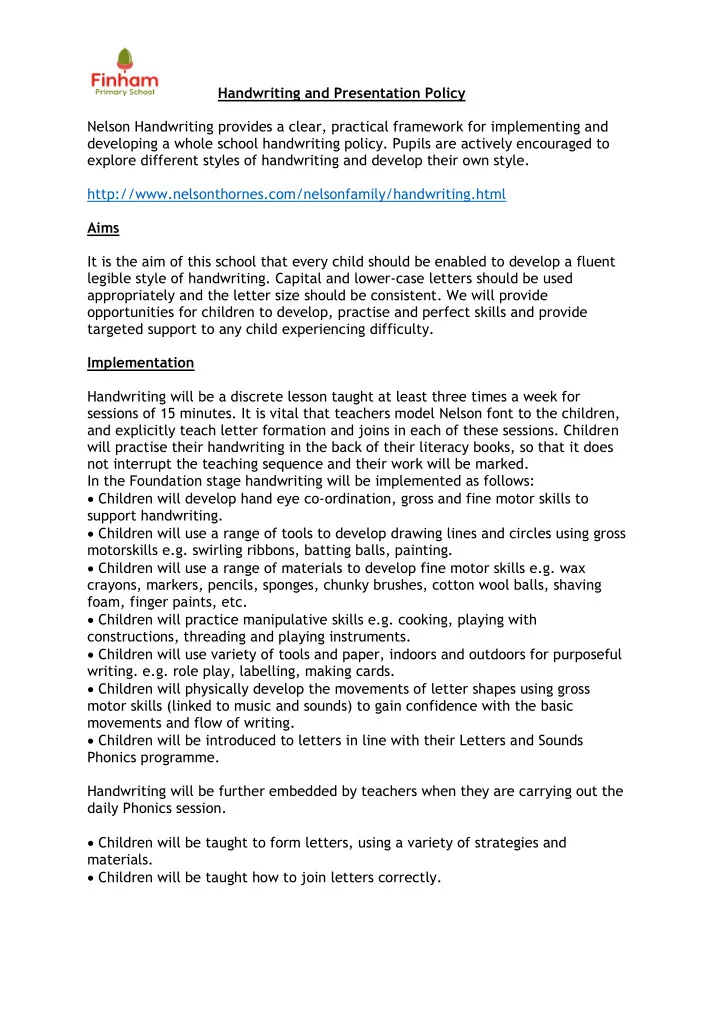

Handwriting and Presentation Policy Nelson Handwriting provides a clear, practical framework for implementing and developing a whole school handwriting policy. Pupils are actively encouraged to explore different styles of handwriting and develop their own style. http://www.nelsonthornes.com/nelsonfamily/handwriting.html Aims It is the aim of this school that every child should be enabled to develop a fluent legible style of handwriting. Capital and lower-case letters should be used appropriately and the letter size should be consistent. We will provide opportunities for children to develop, practise and perfect skills and provide targeted support to any child experiencing difficulty. Implementation Handwriting will be a discrete lesson taught at least three times a week for sessions of 15 minutes. It is vital that teachers model Nelson font to the children, and explicitly teach letter formation and joins in each of these sessions. Children will practise their handwriting in the back of their literacy books, so that it does not interrupt the teaching sequence and their work will be marked. In the Foundation stage handwriting will be implemented as follows: • Children will develop hand eye co-ordination, gross and fine motor skills to support handwriting. • Children will use a range of tools to develop drawing lines and circles using gross motorskills e.g. swirling ribbons, batting balls, painting. • Children will use a range of materials to develop fine motor skills e.g. wax crayons, markers, pencils, sponges, chunky brushes, cotton wool balls, shaving foam, finger paints, etc. • Children will practice manipulative skills e.g. cooking, playing with constructions, threading and playing instruments. • Children will use variety of tools and paper, indoors and outdoors for purposeful writing. e.g. role play, labelling, making cards. • Children will physically develop the movements of letter shapes using gross motor skills (linked to music and sounds) to gain confidence with the basic movements and flow of writing. • Children will be introduced to letters in line with their Letters and Sounds Phonics programme. Handwriting will be further embedded by teachers when they are carrying out the daily Phonics session. • Children will be taught to form letters, using a variety of strategies and materials. • Children will be taught how to join letters correctly.
Handwriting and Presentation Policy • Parents will be given opportunities to support their child to practise their letter formation at home. Teachers will send home materials to enable parents to do this. Across the Primary Age Range Teachers and Teaching Assistants should: • Have high expectations; valuing work that is the child's best effort and supporting when it clearly is not • Identify left handed children and make sure they have sufficient space in which to work • Provide appropriate paper and pencils and/or pens (i.e. all pencils must be sharp and of a reasonable length) • Model how to hold a pencil correctly • Reinforce how to form letters, using a variety of strategies and materials • Reinforce how to join letters correctly • Monitor children's progress through regular assessments and observations of how letters and numbers are formed • Implement intervention for those children not forming letters or numbers correctly • Encourage children to assume a correct sitting position in order to write - both feet on the floor etc. • Where necessary, group children and provide differentiated tasks; engaging whole year teams in planning and support • Modelling good handwriting; on the board, in marking children's work, displays, use Nelson handwriting font on teaching materials where possible etc • Allow children with very poor fine motor skills to print and not make joins. Children should: • Take pride in their work (All children) • Learn to write clearly recognisable letters and form them correctly (EYFS) • Know which letters join to others and which do not (KS1) • Be able to join letters appropriately (KS1) • Enhance speed and fluency in order to develop a legible individual style (KS2) • Demonstrate correct letter formation and joins learnt in all handwriting across the curriculum (KS1 and KS2) Guidance on teaching and learning of handwriting . Handwriting should be taught for at least 15 minutes, three times a week. Each session will have a clear focus and the children will watch the teacher modelling letter formation and/or joins. It may be that it will be more appropriate to group the children in order to differentiate, but the children must see an adult modelling the writing! Work must be initialled, so over the course of the week every child will have had their letter formation observed by an adult. Some general points • Nelson Handwriting scheme provides photocopiable sheets, but nothing is more effective than a teacher modelling letter formation and joins. • We do not join descenders e.g. f g j y
Handwriting and Presentation Policy • When all the skills have been taught use the assessment sheets in Nelson Handwriting scheme to check:- Are all the letters the same size? Are all the down strokes parallel? Are the height and length of ascenders and descenders regular? Is the space between letters even? Is spacing between words even? Is the writing a reasonable size? Could presentation be improved? For fluent writers extend skills by: Encouraging children to evaluate their own and others' writing. Attempt to write faster retaining fluency and legibility - setting time challenges for each other. Additional resources to support children with fine motor control difficulties can be obtained from the SENCo and each individual case assessed to ensure it meets the child’s need. Policy Written – May 2018
Recommend
More recommend